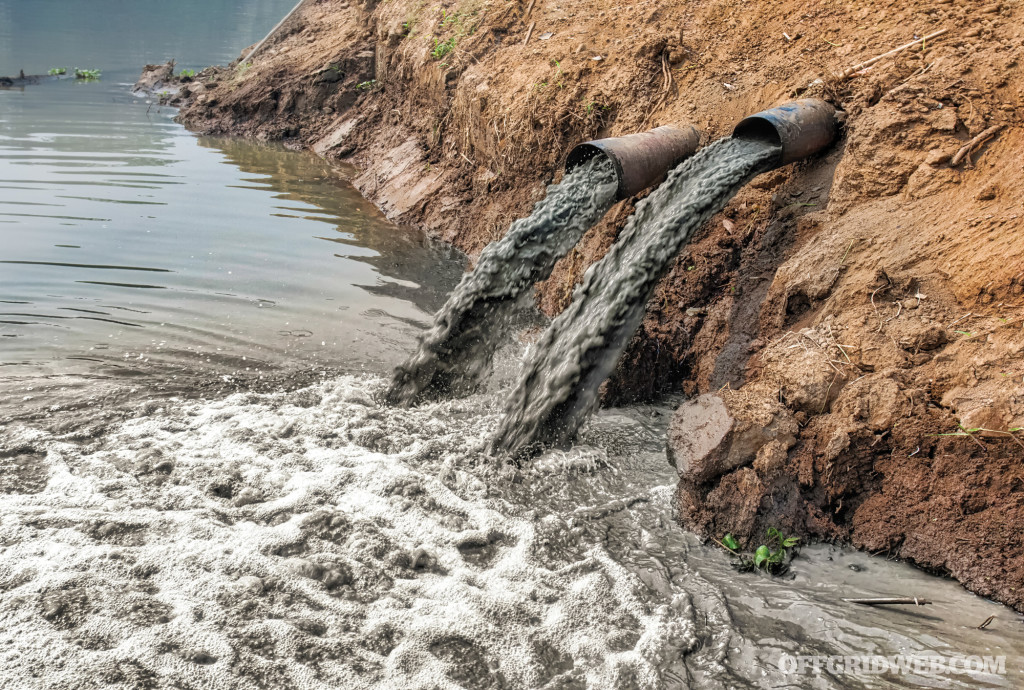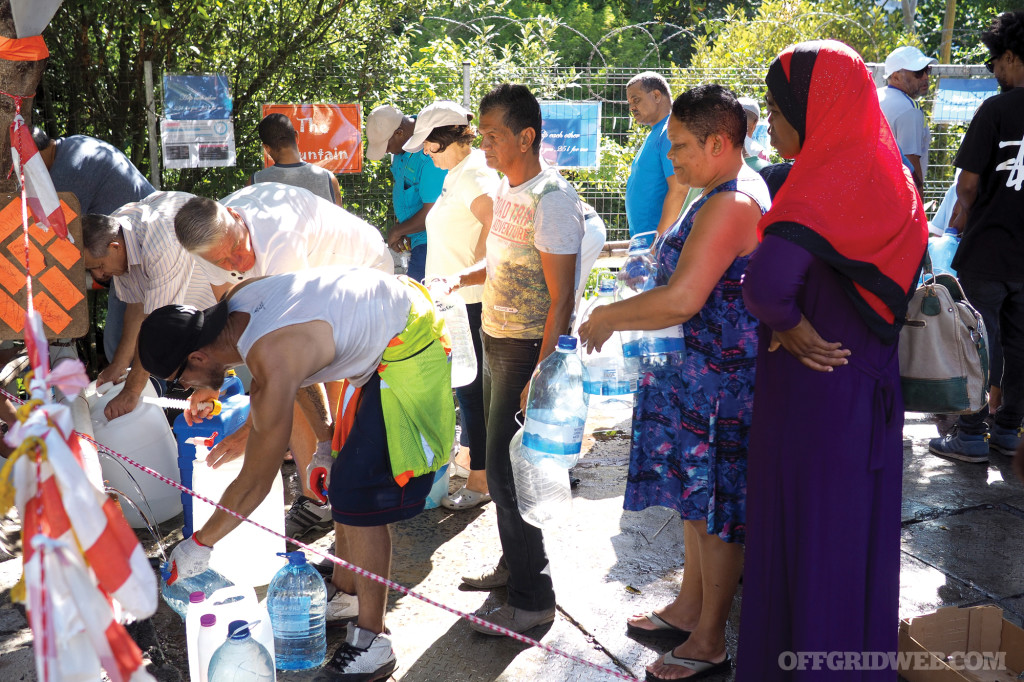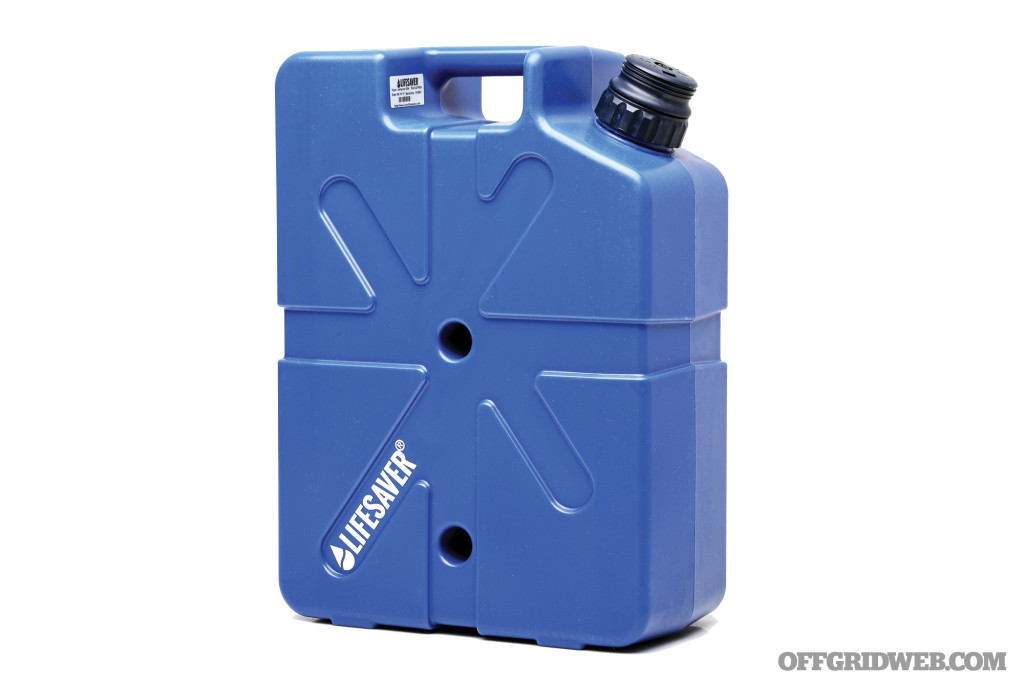RECOIL OFFGRID Preparation Fluid Thinking: Long-Term Water Storage for Survival
In This Article
Water. It’s so essential to life that in a matter of three days or less, most human beings will die without it. Depending on age and gender, the human body is made up of between 50- and 75-percent water. Nevertheless, many of us take water for granted. The latest medical statistics show that about three quarters of Americans are frequently dehydrated, shocking given our country’s widespread availability of clean water. The tragedy, however, is that for many in this world, procuring potable water is an all-day chore, making it a resource more valuable than gold.
What most Americans don’t realize is that our world is in a serious water shortage crisis. Seventy percent of our planet is covered by water, so it may be easy to think that this resource will always be plentiful. Fresh water, the water we drink and bathe in, is very rare, by comparison. Only 3 percent of our water sources on Earth are made up of fresh water, according to the United Nations. Most of that fraction can only be found in glaciers, making it fairly inaccessible.
The World Health Organization (W.H.O.) estimates that almost 1.1 billion people live without clean drinking water, while another 3 billion find water scarce for at least one month of the year. Many in the world are exposed to water-borne diseases, such as cholera and typhoid fever, while over 2 million people — most of whom are children — die each year from diarrhea due to water-borne pathogens. By 2025, the UN estimates that almost two thirds of the world’s population will live in areas of the world that suffer water scarcity as our ecosystem adversely changes. This growing problem can be attributed to several factors.

Climate Change
Over the past few decades, we’ve seen an increase in volatile weather patterns and changes in our water supply throughout the world. While some regions may suffer an increase in flooding, others may experience increased droughts. As glaciers continue to melt, freshwater supplies to downstream communities are often affected. The combination of climate changes may cause less water to be available for agriculture, and decreased energy generation for cities and ecosystems around the world.
Dr. Ali Khan, dean of the College of Public Health at the University of Nebraska Medical Center, believes that there’s a significant correlation between climate change and water scarcity. “Perhaps the greatest compounding factor of existing infectious diseases will be climate change. Climate change will affect soil moisture, which affects the size of harvest, even as increased heat decreases the nutritional value of foods, including the protein content of wheat and rice. The specific effects of global climate change in any given location will vary from drought leading to desertification to rising seawater, leading to massive flooding.”

Industrial pollution continues to contaminate clean water supplies and contribute to ongoing water shortages around the...
Pollution
From pesticides to untreated human wastewater, water pollution is on the rise in the world. Many sources of groundwater are also seeing an increase in contamination as many industrial chemicals leach into underground aquifers. High levels of pollutants can immediately make people sick and cause massive illness outbreaks. Their effects can also be long-lasting and overlooked for years, in which case the damage has already been done to our environment and health.
Agriculture
The world’s agricultural system utilizes over 70 percent of its freshwater supply, but over 60 percent of this water is wasted due to faulty irrigation systems, inefficient water application methods, and the cultivation of crops that are too thirsty for their given environments. The inefficient use of agricultural water thus dries out the world’s rivers, lakes, and underground aquifers, making some countries in danger of reaching their water resource limit. Add to this the high amounts of pollution due to fertilizers and pesticides, and it becomes clear that increasing harm to our environment and society are soon to follow.
Population Growth
In the last 50 years, the human population has doubled in size, along with its drain on the planet’s resources due to industrialization and increased world hunger. Dr. Khan notes that, “More and more people move to urban areas, creating megacities that dwarf the likes of New York and London, some with peri-urban slums where people live in proximity to livestock. Meanwhile, population growth in general, along with the choices that people make about land use, has led to increasing encroachment on open spaces and disruption of ecosystems.” Because populations tend to build around sources of water, the increase in the world’s population has stressed its water basins, therefore decreasing the availability of fresh water to the planet.
Natural Disaster
Although not necessarily a factor for long-term water shortage, natural disasters adversely affect communities in the short term, often resulting in increased disease transmission and pollution. History provides countless examples of how the lack of freshwater has destroyed civilizations and communities, but Puerto Rico’s devastation due to Hurricane Maria serves as a prime example of how natural disasters can decimate local freshwater supplies.

Water shortages typically accompany the aftermath of natural disasters and often lead to water-borne disease outbreaks.
Moreover, hurricanes aren’t the only destructive force that can cause a water crisis. In 2010, Haiti experienced one of the worst earthquakes in the world’s history, killing more than 92,000 civilians. Of those who died, close to 10,000 died from a cholera outbreak due to unsanitary water conditions. This is particularly due to the 890,000 Haitians who were displaced after the disaster, which in turn stressed an already weak freshwater infrastructure. This furthers the evidence that human displacement and migration only add to the scarcity of fresh water.
For many Americans, the need to store fresh water might be extremely low on their daily list of priorities. With many disasters, nothing is a priority until we don’t have it. But what if we don’t experience an Armageddon-style event, and the problem is subtle, gradual, and causing collateral damage? The 2011 California six-year drought put many of the state’s farmers out of business and devastated its ecosystem. In turn, the world food industry suffered a major economic blow due to California’s drought conditions, thus raising food industry prices throughout the world … all because water was scarce in one state.
Disasters and water scarcity, though, are as varied as the regions they affect. Survival expert and author Creek Stewart notes that, “The only event that people should have real concern with are the natural disasters that happen in their areas routinely. It’s typically natural disasters that lead to some sort of water disruption, whether that’s the loss of local utilities or the pollution of a community’s water supply. Typically, a lack of water stems from a lack of electricity or a grid-down scenario that is directly tied to a natural disaster.”
Because we should have a good idea of what disasters may affect us based on where we hang our hat, we can plan ahead for how readily we should store water and in what amounts. Whether it be the loss of power for several weeks or toxic contamination as seen with high levels of lead in Flint, Michigan’s water supply, every American can and should find a reason to store emergency water in their homes.
There are several ways that we can store fresh water in our homes based on a variety of budgets, a little ingenuity, and some education on storage and filtration principles. At a minimum, people need about 1 gallon of water per day, the recommended amount according to the Centers for Disease Control and Prevention (CDC). Everyone should consider what his or her basic needs are, and if we tracked every drop, we’d probably be surprised at how much water we consume each day.
Beyond basic drinking water, most of us should factor in activities such as hand washing, sanitation, cooking, bathing, and washing our clothes. Storage of water should also be realistically taken into account depending on where we live. Jonathan Yoder, from the Waterborne Disease Prevention Branch at the CDC, emphasizes the importance of water storage based on our residence of choice: “I think that there could be different considerations of water storage based on where you live. If you live in the desert and there are no streams, and every bit of water you have has to be stored, then that would be a different consideration than if you lived in a place in the country with a stream nearby, and you have a means to filter that water. This would be an example of understanding your environment in terms of adequate and safe water storage.”
Water storage should also be increased for children, the elderly, and pregnant women. It’s also important to remember that our pets need water, and should be considered when developing a daily water usage plan. Keep at least two week’s worth of drinkable water based on your needs analysis. Yoder also suggests that water should be stored in “containers meant for water, be it buckets or bladders specifically designed to store only water. They should also be food-grade containers. You certainly wouldn’t want something that has had chemicals in it or other things that could be harmful or have a bad taste or odor.”
To properly store our water, there are several food-grade options to consider, each with their pros and cons:
Stackable Water Containers
Most of these water containers are made with heavy-duty, dark plastic (typically blue) and can be stacked on top of each other to save room. Each container typically contains a spigot and handle to easily transport and dispense water, usually coming in 5- to 7-gallon capacities. Most stackable containers can be found in the camping section of almost any department store and average between $15 and $20 a piece. Be careful not to get overzealous with stacking them though. Stacking too many can result in containers at the bottom cracking under the weight.

Some water storage containers, such as this JerryCan 10000UF from LifeSaver, have integrated filters.
Collapsible Water Containers
The benefit of a collapsible water container is the obvious storage capability. Much like stackable containers, they’re usually fitted with a spigot and handle. Because the containers are collapsible, the materials used aren’t as rigid as more permanent water containers. While most hold 3 to 5 gallons, owners should make sure that they don’t overfill them as the increased pressure can possibly make them rupture with long-term use.
Bladders
Most home-use water bladders are typically large, can fit inside sinks or bathtubs, and store large amounts of water. Many bathtub water bladders can store up to 100 gallons and come with kits to siphon the water out. The drawback is two-fold: First, it monopolizes an entire bathtub until drained, so hopefully families have more than one bathtub or shower to use. Second, once filled, don’t make any plans to move the bladder until the water is drained, since a full bathtub bladder may weigh well over 100 pounds. There are water bladders on the market that are more heavy duty and can be stored outside, but the tradeoff of losing integrity of the material due to heat, or potentially puncturing it, should be considered.
Above: Check out our previous review of this bathtub water storage kit from AquaPodKit.
2-Liter Soda Bottles
Two-liter soda bottles are a fantastic way to store water cheaply. If you live in the city or a small apartment, 2-liter soda bottles can be collected, washed out thoroughly, filled with water, and stored with relative ease in a closet or food pantry. The plastic of the 2-liter soda bottle is also made of longer-lasting material than most milk jugs we buy from our local grocery stores.
Rain Barrels
Some stored water isn’t suitable to drink without proper filtration and purification, but can be used for non-potable purposes, such as plant irrigation. Utilizing barrels that collect rainwater is a great option for collecting non-consumable water. Rain barrels come in a variety of sizes and styles.
Heavy-Duty Water Barrel
A 55-gallon blue barrel is made of rigid, food-grade plastic and can store enough water for almost two months for an individual. Creek Stewart notes that, “In the past 10 years, the market has exploded in options for water storage. If I were to choose a way for a family to store water, it would be in a 55-gallon food grade drum. The price of the drum itself is very affordable, and they’re sold in ready-to-go kits that are offered in a number of major retailers that can run you anywhere from $100 to $179.” If you have a family, you can upgrade to either add more blue barrels, or dish out the change for an upgraded version of a heavy-duty water container that holds several hundred gallons. Just be sure that once you select your heavy-duty water containment site, you stick a fork in it and call it done, because once it’s filled, it’ll take the strength of Samson to move it.
Yoder suggests, “Store your water in a place that’s dark and cool, which limits the amount of sunlight coming into it. This preserves the water as long as possible, because if the water warms up, the water degrades much quicker than if kept cool.” Creek Stewart agrees and adds, “The number-one factor in storing water long-term is temperature. You always want to store water in a cool, dry place. Under a stairwell, or a closet, but the basement is best. You never want to store water in an attic or a garage where it’s going to be really hot.”
Both the CDC and FEMA (Federal Emergency Management Agency) urge that water that hasn’t been commercially bottled should be replaced every six months. In addition, check the expiration date on purchased water to ensure that the product is of the safest value to you and loved ones.
Long-term water storage isn’t just for lone survivalists and those preparing for the apocalypse. It boils down to promoting good common sense that each one of us should follow. Although the water in our homes is generally safe, Yoder reminds us about what we take for granted on tap: “There are times when a water main breaks or water gets contaminated, so it’s a good idea for people to store water.” Yoder, Creek Stewart, and Khan all see the writing on the wall when it comes to the increasing scarcity of the Earth’s fresh water supply.
Yoder continues, “I think that there are some clues that people should look out for, and use that as a reminder to store up what they and their family might need. I think that it’s certainly prudent for people to have water stored up for any kind of occasion.” Stagnant thinking is much like stagnant water. It goes nowhere and leads to diseased thoughts. If the human-race is to get ahead of the world’s water crisis, it’ll take personal diligence to ensure our long-term water storage needs are met for ourselves and loved ones. It’ll also take flexible and forward acts of conservation by all of us to ensure others in this world share the same luxury of fresh water as we do.
Filtering Water
Maybe you’ve thought ahead and decided to store your water long before a disaster hits. Bravo! For many people, storing water only becomes a concern in the days or hours immediately preceding a disaster. In a true emergency, or after the disaster has happened, people attempt to obtain their water in the worst of conditions, which is typically unsanitary and non-potable at the time.
Disasters rarely grant us the forewarning needed to secure our basic survival needs if we haven’t prepared ahead of time. For those in this situation, unless provided by the government, nonprofit disaster relief organization, or the best of good Samaritans, the water that’s collected will more than likely need to be filtered and purified before it can be used for drinking — especially if the water source is unknown.
Purifying Water
Many make the mistake of thinking that filtering water is the same as purifying water. This misunderstanding often means the difference between staying hydrated and losing your fluids through bouts of vomiting and diarrhea. Micro-filtering can remove many harmful bacteria and protozoan cysts, but it doesn’t eliminate the viruses that cause diseases, such as dysentery, cholera, typhoid, and hepatitis.
Chemical Purifiers
There are several chemical purifiers that can be purchased, such as purification tablets and iodine. “They’re all different,” says survival instructor Creek Stewart. “Some only purify a liter, some do five gallons, so it’s really important to read the instructions on the type of chemical purifiers that you’re using. Also, chemical purifiers in general only work in clear water. They don’t work on water that’s milky or cloudy, or has silt, where it’s a lot less effective. The second thing about chemical purification tablets is that they don’t work immediately. They typically take anywhere from 30 minutes to an hour for the purifiers to affect the water they’re treating.” Jonathan Yoder adds to Stewart’s sentiment on chemical purifiers. “You also have chlorine dioxide tablets and iodine, but you certainly don’t want to use iodine for an extended amount of time. It’s very much for short periods.”
Chlorine Purification
One common method of purifying water is to add a small amount of household bleach. To ensure that you retain the highest level of purification, only use regular, unscented chlorine bleach that’s intended for disinfection as the label indicates. Users of household bleach should look for an active ingredient that contains 6 or 8.25 percent of sodium hypochlorite. Avoid scented, color-safe, or bleaches with added cleaners. Using a clean medicine dropper, add either eight drops of 6-percent bleach or six drops of 8.25-percent bleach to each gallon of water. If the water is cloudy, colored, or very cold, then the amount of bleach should be doubled. After the bleach has been added, stir the water and let it stand for 30 minutes. If the water doesn’t have a slight chlorine odor, repeat the dosage and let it stand for another 15 minutes before using.
Purifying Water with Bleach
Boiling Water
The ultimate in home water purification is boiling water. Boiling sufficiently kills pathogenic bacteria, viruses, and protozoa. However, it isn’t effective at removing chemical or metal contaminants in water. If the water is cloudy, it’s best to first let it settle and filter it either through a clean cloth or coffee filter. After your water is clear, bring it to a rolling boil for a minimum of one minute to be safe — three minutes if you live at an altitude above 5,000 feet. After boiling, let the water cool to store it in suitable containers. Boiled water usually tastes flat, so to improve its taste, add a pinch of salt to each liter of water or pour it from one clean container to another several times.
Long-Term Fuel Storage
Contrary to what you've seen in post-apocalyptic movies and TV shows, gasoline will eventually expire and render motorized vehicles inoperable. However, like water, the shelf life of gas and diesel can be extended substantially with proper preparation and storage techniques. We discuss some steps you can take to keep your bug-out vehicle fueled after SHTF in the following OFFGRIDweb article: www.offgridweb.com/?p=9351
 Dr. Ali Khan
Dr. Ali Khan
Rear Admiral Ali S. Khan is a Pakistani-American practicing physician and former Director of the Office of Public Health Preparedness and Response (PHPR) at the Centers for Disease Control and Prevention. Since July 2014, he has served as dean of the College of Public Health and Retired Assistant General at the University of Nebraska Medical Center in Omaha, Nebraska. www.unmc.edu/publichealth/departments/epidemiology/facultyandstaff/ali-khan.html
 Jonathan Yoder
Jonathan Yoder
Jonathan Yoder is the deputy branch chief and water preparedness and response coordinator for the Waterborne Disease Prevention Branch in the National Center for Emerging Zoonotic and Infectious Diseases (NCEZID) at the Centers for Disease Control and Prevention (CDC). In this role, he works to develop and coordinate waterborne disease outbreak and response activities. Yoder has worked in waterborne disease outbreak and emergency response since joining CDC in 2003. He deployed to support CDC’s Ebola response activities in Liberia and Sierra Leone during 2014 to 2015 and CDC’s hurricane response activities in U.S. Virgin Islands and Puerto Rico in 2017. www.cdc.gov/healthywater/emergency/index.html
 Creek Stewart
Creek Stewart
Creek Stewart is a survival instructor and host of the Weather Channel’s SOS: How to Survive, and previous host on the Weather Channel’s hit show Fat Guys in the Woods. He has authored over eight books and has been featured as one of the nation’s leading subject matter experts on survival on several television programs and magazine interviews. In 2015, Creek was presented with the NESA Outstanding Eagle Scout Award (NOESA) by the Boy Scouts of America. www.creekstewart.com
Don’t miss essential survival insights—sign up for Recoil Offgrid's free newsletter today!
Read articles from the next issue of Recoil Offgrid: Issue 29
Read articles from the previous issue of Recoil Offgrid: Issue 27
Check out our other publications on the web: Recoil | Gun Digest | Blade | RecoilTV | RECOILtv (YouTube)
Editor's Note: This article has been modified from its original version for the web.
 STAY SAFE: Download a Free copy of the OFFGRID Outbreak Issue
STAY SAFE: Download a Free copy of the OFFGRID Outbreak Issue
No Comments